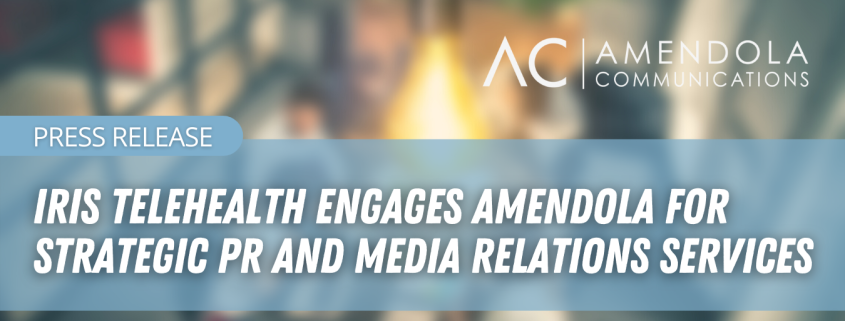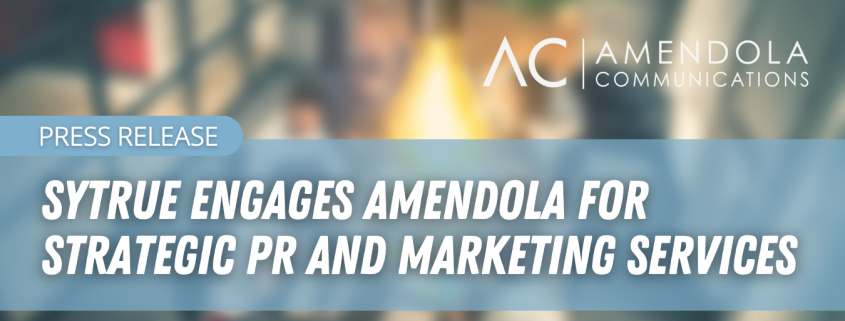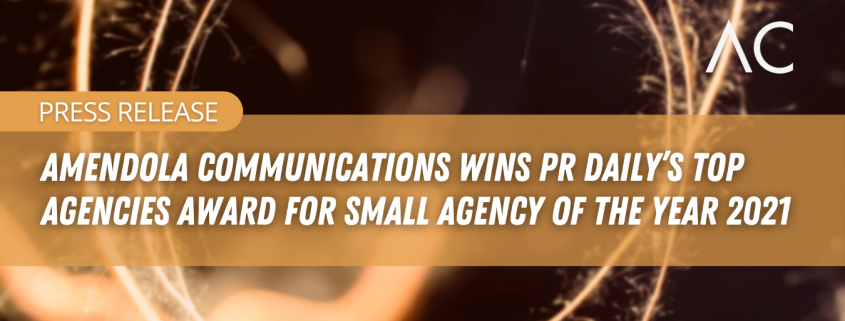
by Administrator | Jul 7, 2022 | News
SCOTTSDALE, Ariz. July 7, 2022 – Amendola announced today that it has won a 2022 Bulldog PR Award in the Best Thought Leadership category for its HSBlox campaign, solidifying the company’s reputation as a top public relations (PR) and marketing communications agency for healthcare and health IT. The Bulldog PR Awards, which celebrate the best and brightest corporate communications and PR efforts, honored Amendola with a Bronze award for a campaign it developed to increase awareness of HSBlox in the value-based care (VBC) space.
The overarching goal of the campaign was to communicate the challenges of VBC models and the ways in which HSBlox uses contract modeling, network build-out, contract administration, permissioned data exchange and payment technologies to integrate traditional medical networks with non-medical ones (i.e., social services agencies, community-based organizations) to bring VBC administration to fruition. Amendola set on a course of creating third-party references by engaging industry analysts and media outlets. The firm researched top healthcare industry analysts, reporters and publications covering VBC, social determinants of health (SDOH), and health equity. Amendola then built a weekly cadence of media campaigns, alternating among proactive, issues-based pitching; HSBlox news; and thought leadership.
Amendola drafted pitches and contributed content that added new elements to the media and analyst coverage over the last few years. For example, while most coverage focused on the need to address SDOH in VBC program models, fewer articles discussed the challenges of incorporating digitized unstructured data in a way that made it part of a patient’s entire medical record for whole-person health. Lastly, Amendola pitched briefings with top analyst firms covering VBC and the payer markets.
The campaign secured 17 briefings with eight different analyst firms over a 10-month period. Those briefings resulted in four analyst reports or blog posts, 19 pieces of vendor-neutral contributed content, and five podcast appearances.
“We are proud to be recognized for the hard work that our team put into executing this brand awareness campaign,” said agency CEO, Jodi Amendola. “Our PR initiatives enabled HSBlox sales leaders to leverage the earned content created by the campaign to escort prospects through the sales funnel and underscore the importance of the digital infrastructure needed to successfully achieve VBC models.”
About Amendola
Amendola is an award-winning, insights-driven public relations and marketing firm that integrates media relations, social media, content and lead gen programs to move healthcare, life sciences/pharma and healthcare IT decision-makers to action. The agency represents some of the industry’s best-known brands as well as groundbreaking startups that are disrupting the status quo. Nearly 90% of its client base represents multi-year clients and/or repeat client executives. Amendola’s seasoned team of PR and marketing pros understand the ongoing complexities of the healthcare ecosystem and provide strategic guidance and creative direction to drive positive ROI, boost reputation and increase market share. Making an impact since 2003, Amendola combines traditional and digital media to fuel meaningful and measurable growth. For more information about the industry’s “A-Team,” visit www.acmarketingpr.com, and follow us on Twitter and LinkedIn.
About HSBlox
HSBlox is an Atlanta-based technology company empowering healthcare organizations with the tools and support to deliver value-based care (VBC) successfully and sustainably. HSBlox’s CureAlign® platform enables healthcare organizations to administer value-based programs, including contract modeling, network build-out, contract administration, permissioned data exchange and payment. Recently, the company released CureAlign 3.5, combining its Contract Builder and modeling capabilities with its Contract Library for seamless deployment of value-based programs. Along with CureAlign’s one-of-a-kind hierarchical approach to VBC participant onboarding, alternative payment models can combine global reimbursement programs with episode-specific arrangements to deliver unparalleled transparency in pursuit of the Quintuple Aim for healthcare improvement.
Follow HSBlox on LinkedIn to see the latest about value-based program administration or visit www.hsblox.com to read more about scaling of value-based programs.
Media contact:
Marcia Rhodes
Amendola Communications
mrhodes@acmarketingpr.com

by Administrator | May 18, 2022 | News
SCOTTSDALE, ARIZ., May 18, 2022 — The Association of Marketing and Communication Professionals has named Amendola, a nationally recognized, award-winning healthcare and health IT public relations and marketing agency, as a Gold Winner in the 2022 Hermes Creative Awards competition. Amendola earned the award in the Strategic Campaigns category for a thought leadership program the agency executed on behalf of value-based care (VBC) administration pioneer HSBlox.
In a VBC system, providers such as hospitals and doctors are paid by health insurers based on patient outcomes rather than the current “fee-for-service” model. Ultimately, payers reward medical providers for helping patients become healthier.
The award-winning thought leadership campaign, which ran from February 2021 through February 2022, focused on raising awareness of data and payment exchange challenges—and solutions—associated with VBC models. Specifically, the program illustrated how HSBlox technology enables timely payment of services to social services agencies.
Amendola built a weekly cadence of media campaigns that included proactive, issues-based media pitching, company news and general thought leadership. Amendola successfully crafted new, creative story angles for media around emerging VBC models and secured briefings with top analyst firms covering payer markets.
The campaign yielded impressive results, including 17 briefings with eight analyst firms, 19 pieces of vendor-neutral content placed in high-value media outlets and five podcast appearances.
“The value-based care landscape is a crowded, competitive market that makes it difficult for any one player to stand out,” agency CEO Jodi Amendola explained. “To set HSBlox apart, we targeted analysts and publications focused on value-based care and health equity and positioned HSBlox as an innovator and valued resource.”
HSBlox solutions assist healthcare stakeholders at the intersection of value-based care and precision health with a secure, information-rich approach to event-based, patient-centric digital healthcare processes—empowering whole health in traditional care settings, the home and in the community.
“Our team’s work armed HSBlox’s sales leaders with high-value content to help move prospects through the sales funnel by underscoring the value of their digital infrastructure for success in a value-based care environment,” Amendola said.
AMCP’s Hermes Creative Awards is an international competition for creative professionals involved in the concept, writing and design of traditional and emerging media. AMCP consists of several thousand marketing, communication, advertising, public relations and digital media professionals.
About Amendola
Amendola is an award-winning, insights-driven public relations and marketing firm that integrates media relations, social media, content and lead gen programs to move healthcare, health IT and life sciences decision-makers to action. The agency represents some of the industry’s best-known brands as well as groundbreaking startups that are disrupting the status quo. Nearly 90% of its client base represents multi-year clients and/or repeat client executives. Amendola’s seasoned team of PR and marketing pros understand the ongoing complexities of the healthcare ecosystem and provide strategic guidance and creative direction to drive positive ROI, boost reputation and increase market share. Making an impact since 2003, Amendola combines traditional and digital media to fuel meaningful and measurable growth. For more information about the industry’s “A-Team,” visit www.acmarketingpr.com, and follow us on Twitter and LinkedIn.
###
Media contact:
Marcia Rhodes
MRhodes@acmarketingpr.com

by Administrator | Apr 26, 2022 | News
Award-winning health tech PR agency to elevate the profile of telepsychiatry service provider
SCOTTSDALE, Ariz., April 26, 2022 – Amendola Communications, a nationally recognized, award-winning healthcare and technology marketing and public relations firm, announced that Iris Telehealth, a leading provider of telepsychiatry services for community mental health centers, community health centers, hospitals, and health systems across the U.S., has selected the firm to manage PR, media relations, and thought leadership. Iris conducted an extensive agency search and selected Amendola for its successful track record, industry acumen, and bench strength.
“The COVID-19 pandemic has magnified the importance of addressing mental health as a part of overall public health,” said agency CEO Jodi Amendola. “Providing easy and convenient access to accredited psychiatric services from quality behavioral health professionals is essential to this effort. Iris Telehealth’s use of telemedicine to expand clinically sound psychiatric services to patients and healthcare organizations is making a tangible impact in this regard, and we’re enthused to help execute their vision of enabling a better world through healthy minds.”
Amendola is implementing a comprehensive public relations, thought leadership, communications, and media plan for Iris Telehealth that will showcase its value proposition, services, accomplishments, customer wins, and industry partnerships. The agency successfully kicked off the relationship by supporting the Austin, Texas-based company’s recent Series B funding. Amendola garnered significant media coverage for this major milestone, including an audience reach of more than 61 million via placements in high-profile healthcare trade and business media such as MobiHealthNews, MedCity News, Digital Health Business and Technology, Axios, Fortune, and STAT as well as local Austin media.
“There’s a nationwide need to provide timely, quality behavioral healthcare, and our track record shows we can help health systems and community organizations sustainably improve care for their communities,” said Dan Ferris, Chief Marketing Officer of Iris Telehealth. “We’re teaming up with Amendola Communications to drive awareness of our unique value to the healthcare market and our mission of supporting the mental wellbeing of patient populations that need it most. Our Series B announcement was our first effort to gain more market awareness and we know that with Amendola’s help, this is just the beginning.”
Iris Telehealth has grown exponentially over the last 18 months as healthcare organizations seek to provide timely, quality care to their patients. Iris’s combination of high-quality providers, best-in-class support, expertise to optimize care models, and technology has enabled customers to reimagine how behavioral health services are provided across the continuum of care.
About Amendola Communications
Amendola is an award-winning, insights-driven public relations and marketing firm that integrates media relations, social media, content, and lead gen programs to move healthcare, life sciences/pharma and healthcare IT decision-makers to action. The agency represents some of the industry’s best-known brands as well as groundbreaking startups that are disrupting the status quo. Nearly 90% of its client base represents multi-year clients and/or repeat client executives. Amendola’s seasoned team of PR and marketing pros understand the ongoing complexities of the healthcare ecosystem and provide strategic guidance and creative direction to drive positive ROI, boost reputation and increase market share. Making an impact since 2003, Amendola combines traditional and digital media to fuel meaningful and measurable growth. For more information about the industry’s “A-Team,” visit www.acmarketingpr.com, and follow us on Twitter and LinkedIn.
About Iris Telehealth
Iris Telehealth helps healthcare organizations consistently increase access to quality mental healthcare for their patients by providing the clinicians, staff support, and knowledge to build a sustainable telepsychiatry department. With clinical grounding and emphasis on human relationships, Iris Telehealth identifies best-fit providers for each unique organization and ensures long-term commitment to meeting their partner’s needs, allowing them to provide the highest quality care to their patients and community. For more information, please visit iristelehealth.com.
Media Contact:
Marcia Rhodes
Amendola Communications
mrhodes@acmarketingpr.com

by Administrator | Apr 5, 2022 | News
Award-winning Healthcare IT PR agency to collaborate with leader in modernizing payer workflows to amplify client successes and industry best practices
SCOTTSDALE, Ariz., April 5, 2022 – Amendola Communications, a nationally recognized, award-winning healthcare and technology public relations and marketing firm, announced that SyTrue, the leader in modernizing payer workflows to reduce costs and increase efficiencies, has selected the firm as its agency of record to amplify client successes and industry best practices after a competitive review of agencies.
SyTrue enables healthcare payers to make sense of fragmented, dirty data, driving greater transparency that increases productivity, reduces costs and enhances revenue. SyTrue’s innovative clinical Natural Language Processing (NLP) Operating System NLP OS™ synthesizes, normalizes and transforms unstructured clinical data into a strategic enterprise-wide digital asset that catalyzes informed decision-making for risk adjustment, care coordination and payment integrity.
“As a result of fragmented, incomplete patient data, health plans routinely miss opportunities to improve payment integrity, risk adjustment and population health,” said SyTrue Founder and CEO Kyle Silvestro. “We look forward to partnering with Amendola to share the story of how SyTrue enables payers to make sense of disorganized data to increase productivity, reduce costs and enhance revenue.”
“Issues such as inaccurate payments, unneeded tests and procedures and overly complex pricing cost health plans millions of dollars a year in lost revenue,” said agency CEO Jodi Amendola. “With its NLP OS™ enterprise solution that reads and understands medical records, SyTrue is fundamentally improving the way healthcare experts interact with patient records.”
Amendola is implementing a comprehensive media and communications plan for SyTrue that will showcase the company’s current technology and services, new offerings, accomplishments, customer wins, and industry partnerships. Recently, SyTrue announced that SyTrue payer clients benefited from 35% to 55% increases in productivity and ROIs between $13 and $28 per audit using SyTrue’s payment integrity tools and services. SyTrue also shared that in 2021, it capped off a year of tremendous growth in the company’s client base, number of employees and transaction volume.
About Amendola Communications
Amendola is an award-winning, insights-driven public relations and marketing firm that integrates media relations, social media, content and lead gen programs to move healthcare, life sciences/pharma and healthcare IT decision-makers to action. The agency represents some of the industry’s best-known brands as well as groundbreaking startups that are disrupting the status quo. Nearly 90% of its client base represents multi-year clients and/or repeat client executives. Amendola’s seasoned team of PR and marketing pros understand the ongoing complexities of the healthcare ecosystem and provide strategic guidance and creative direction to drive positive ROI, boost reputation and increase market share. Making an impact since 2003, Amendola combines traditional and digital media to fuel meaningful and measurable growth. For more information about the industry’s “A-Team,” visit www.acmarketingpr.com, and follow us on Twitter and LinkedIn.
About SyTrue
SyTrue, the leader in modernizing payer workflows to reduce costs and increase efficiencies, enables healthcare payers to make sense of fragmented, dirty data, driving greater transparency that increases productivity, reduces costs and enhances revenue. Healthcare payers must analyze extensive amounts of unstructured data to identify insights from patients’ episodic health records, which cannot be accessed by traditional methods of search and require expensive chart reviews. SyTrue’s innovative clinical Natural Language Processing (NLP) Operating System NLP OS™ synthesizes, normalizes and transforms unstructured clinical data into a strategic enterprise-wide digital asset that catalyzes informed decision-making for risk adjustment, care coordination and payment integrity. Developed by clinicians and data scientists with deep healthcare domain expertise, SyTrue’s solutions boost the productivity of review teams and generate higher ROI on chart reviews through greater accuracy, speed, repeatability and scalability. SyTrue is trusted by top-tier health plans who have leveraged NLP OS™ to process more than 10 billion health records, yielding insights that lead to increased efficiencies and improvements in financial performance.
Media Contact:
Marcia Rhodes | Mrhodes@acmarketingpr.com

by Administrator | Mar 30, 2022 | News
SCOTTSDALE, Ariz., March 30, 2022 — Amendola Communications, a nationally recognized, award-winning healthcare and health IT public relations and marketing agency, today announced it has added another accolade from the PR industry to its resume. Ragan and PR Daily named Amendola as an overall winner in the Small Agency of the Year Category in their 2021 Top Agencies Awards.
PR Daily’s Top Agencies Awards recognize agencies that are conceiving and executing outstanding PR and marketing campaigns. Winners were selected based on the strength of award entry forms submitted by agencies from across the globe.
Amendola highlighted integrated PR, thought leadership, media relations and marketing campaigns it executed for clients, including Biofourmis, Availity®, ABOUT™ and others in its 2021 entry. The award is just the latest national recognition for the agency, which provides a full range of PR and marketing services—including media and analyst relations, messaging, content development and marketing, social media, digital marketing, website design, strategic counsel and more. However, the recognition is particularly rewarding given the industry turbulence experienced over the past year.
“2021 was the second straight year impacted by COVID-19,” says Jodi Amendola, CEO of Amendola Communications. “The healthcare, health tech and life sciences companies we serve faced significant challenges in the wake of the pandemic and our seasoned team of professionals was able to deliver powerful PR and marketing support to educate and influence key target audiences for our clients during this time of need. I’m especially proud of this award from Ragan and PR Daily because it recognizes our agency as a whole and the results we were able to generate for our clients.”
Winners of PR Daily’s Top Agencies Awards will be honored at a special ceremony and luncheon on May 10 at the Yale Club in New York City.
About Amendola Communications
Amendola is an award-winning, insights-driven public relations and marketing firm that integrates media relations, social media, content and lead gen programs to move healthcare, life sciences/pharma and healthcare IT decision-makers to action. The agency represents some of the industry’s best-known brands as well as groundbreaking startups that are disrupting the status quo. Nearly 90% of its client base represents multi-year clients and/or repeat client executives. Amendola’s seasoned team of PR and marketing pros understand the ongoing complexities of the healthcare ecosystem and provide strategic guidance and creative direction to drive positive ROI, boost reputation and increase market share. Making an impact since 2003, Amendola combines traditional and digital media to fuel meaningful and measurable growth. For more information about the industry’s “A-Team,” visit www.acmarketingpr.com, and follow us on Twitter and LinkedIn.
About Ragan Communications
Ragan Communications has been delivering trusted news, training and intelligence for more than 50 years to internal and external communicators, HR professionals and business executives via its conferences, webinars, training, awards, subscriptions and membership divisions. Its daily news sites—PRDaily.com and Ragan.com—are read by more than 600,000 internal and external communicators monthly. Its Communications Leadership Council is one of the fastest-growing membership groups for communications executives and its PR Daily Leadership Network is the go-to membership group for PR, marketing and social media professionals. Ragan’s Workplace Wellness Insider serves HR, wellness and communications professionals. Ragan is also the producer of Communications Week, which is held Nov. 15-19. Ragan is headquartered in Chicago, with team members spanning the country and loyal customers worldwide. Visit www.ragan.com.
Media contact: Marcia Rhodes | MRhodes@acmarketingpr.com




